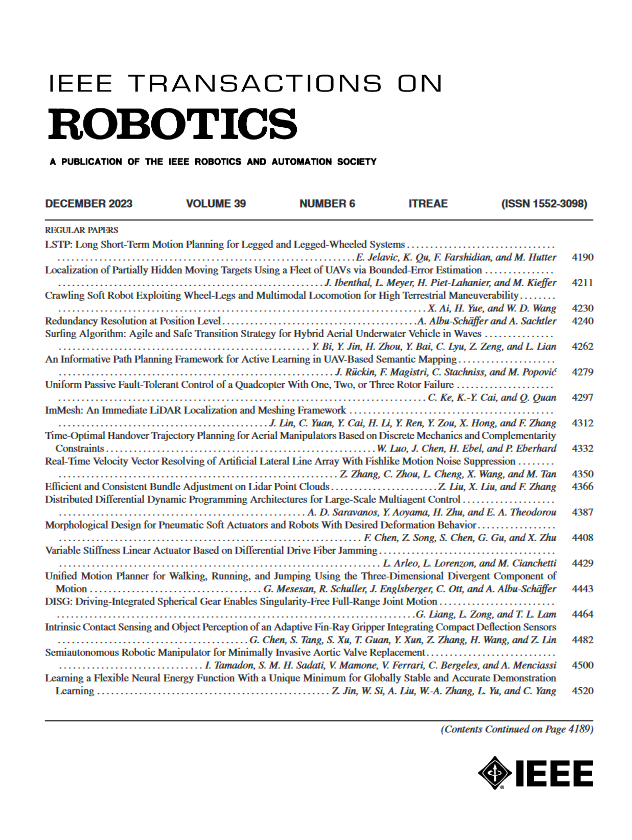Robust and Scalable Multi-Robot Localization Using Stereo UWB Arrays
IF 10.5
1区 计算机科学
Q1 ROBOTICS
引用次数: 0
Abstract
In environments where robots operate with limited global navigation satellite system accessibility, ultra-wideband (UWB) localization technology is a popular auxiliary solution to assist visual–inertial odometry systems. However, current UWB approaches lack 3-D pairwise localization capability and suffer from rapidly declining localization update rates as the network scales, limiting their effectiveness for swarm robotic applications. This article presents a novel UWB sensor that enables 3-D pairwise localization and a localization scheme that can deliver robust, scalable, and accurate position awareness for multi-robot systems. Our approach begins with calibrating intrinsic UWB errors from hardware deviations and propagation effects, yielding high-accuracy distance and direction measurements. Using these measurements, we perform distributed relative localization through inter- and intra-node cooperation by integrating UWB and inertial measurement unit data. To enable swarm-scale operation, our platform implements the signal-multiplexing network ranging protocol to maximize update rates and network capacity. Experimental results show that our approach achieves centimeter-level localization accuracy at high update rates (100 Hz with UWB only), validating its robustness, scalability, and accuracy for robotic applications.基于立体超宽带阵列的鲁棒可扩展多机器人定位
在全球导航卫星系统可及性有限的环境中,超宽带(UWB)定位技术是辅助视觉惯性里程计系统的一种流行的辅助解决方案。然而,目前的超宽带方法缺乏三维配对定位能力,并且随着网络规模的扩大,定位更新率迅速下降,限制了它们在群体机器人应用中的有效性。本文提出了一种新型的超宽带传感器,可以实现三维配对定位和定位方案,可以为多机器人系统提供鲁棒,可扩展和准确的位置感知。我们的方法首先校准由硬件偏差和传播效应引起的固有UWB误差,从而产生高精度的距离和方向测量。利用这些测量,我们通过集成超宽带和惯性测量单元数据,通过节点间和节点内的合作进行分布式相对定位。为了实现群体规模的操作,我们的平台实现了信号复用网络测距协议,以最大限度地提高更新速率和网络容量。实验结果表明,我们的方法在高更新速率(仅UWB时为100 Hz)下实现了厘米级定位精度,验证了其在机器人应用中的鲁棒性、可扩展性和准确性。
本文章由计算机程序翻译,如有差异,请以英文原文为准。
求助全文
约1分钟内获得全文
求助全文
来源期刊

IEEE Transactions on Robotics
工程技术-机器人学
CiteScore
14.90
自引率
5.10%
发文量
259
审稿时长
6.0 months
期刊介绍:
The IEEE Transactions on Robotics (T-RO) is dedicated to publishing fundamental papers covering all facets of robotics, drawing on interdisciplinary approaches from computer science, control systems, electrical engineering, mathematics, mechanical engineering, and beyond. From industrial applications to service and personal assistants, surgical operations to space, underwater, and remote exploration, robots and intelligent machines play pivotal roles across various domains, including entertainment, safety, search and rescue, military applications, agriculture, and intelligent vehicles.
Special emphasis is placed on intelligent machines and systems designed for unstructured environments, where a significant portion of the environment remains unknown and beyond direct sensing or control.
 求助内容:
求助内容: 应助结果提醒方式:
应助结果提醒方式:


